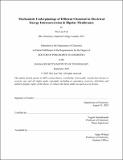Mechanistic Underpinnings of Efficient Chemical-to-Electrical Energy Interconversion in Bipolar Membranes
Author(s)
Toh, Wei Lun
DownloadThesis PDF (29.72Mb)
Advisor
Surendranath, Yogesh
Terms of use
Metadata
Show full item recordAbstract
The efficient operation of all electrochemical devices requires an understanding of how electrical and chemical energy can be freely interconverted with minimal losses. One way in which chemical energy can be stored is in the form of ionic gradients. Bipolar membranes (BPMs) are an emerging technology that have the unique ability to convert the chemical potential gradient within a pH gradient into an electric potential gradient in the form of a membrane voltage (forward bias) and vice-versa (reverse bias). This unprecedented functionality has been utilized to design and construct a suite of electrochemical devices such as water and CO₂ electrolyzers, fuel cells, redox flow batteries, and electrodialyzers that operate with a pH gradient. This in turn has allowed the independent optimization of cathode and anode catalysts, and unlocked new operational modalities such as in operando neutralization for product recovery in CO₂ electrolysis or the extension of the operating voltage window for redox flow batteries, enabling higher energy and power densities. However, despite their utility, the fundamental processes that control the efficiency of chemical-to-electrical energy interconversion in BPMs remain poorly understood, both under open-circuit conditions and under polarization. Hence, the overarching goal of the work in this thesis is to identify these processes and unravel their mechanistic origins in order to develop remediation strategies.
In Chapter 2, we describe how bipolar pairing interactions can arise from the intimate association of fixed charges at the bipolar junction when one of the phases constituting the junction is mobile, leading to attenuation of the membrane voltage and severe overpotential penalties in reverse bias. We find that the use of layered materials as interfacial additives can inhibit these detrimental interactions and significantly improve electrochemical performance.
In Chapter 3, we reveal that BPMs are subject to a process whereby the crossover of coions is coupled to the parasitic neutralization at the bipolar interface, which we term neutralization shortcircuiting. We find that for weak electrolyte-containing BPMs, this process buffers the bipolar interface due to the production of the conjugate acid/base, levelling the membrane voltage to a value dictated by the proton affinity of the conjugate acid/base. In addition, this neutralization product can undergo dissociation under reverse bias, reducing the Faradaic efficiency for the water dissociation reaction.
Finally, in Chapter 4, we discover that, for BPM cells containing mixtures of strong and weak electrolytes, the weak electrolyte can impose a significant neutralization overpotential on the strong electrolyte in voltage regions where the former is unreactive. This occurs as the weak electrolyte imposes an ionic blockade by competing for the same fixed-charge sites in the membrane as the strong electrolyte, inhibiting the transport of the latter. We report on the use of advecting polyelectrolytes and thinner ion exchange membranes as materials strategies for overcoming this transport inhibition, and explain its implications for CO₂ electrolyzers and galvanic cells utilizing forward bias BPMs.
Date issued
2023-09Department
Massachusetts Institute of Technology. Department of ChemistryPublisher
Massachusetts Institute of Technology